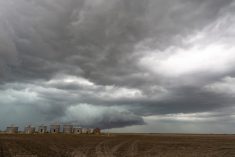Proposed changes to the federal/provincial farm income stabilization program beyond this year are expected to lead to tighter eligibility for a program payout, according to a producer group observing the planning process.
In its Grass Routes newsletter last week, Alberta Beef Producers reported some suggestion among federal and provincial agriculture ministers that governments should "rebalance their books to increase producer responsibility for ‘normal risk.’"
As commodity prices increase across many agriculture sectors the cost of business risk management (BRM) programming in Growing Forward, the federal/provincial farm policy funding framework that expires this year, is also increasing, ABP said.
Read Also

Canadian trade data delayed by U.S. government shutdown
Canadian international trade data for September will be delayed indefinitely due to the ongoing partial shutdown of the United States government, Statistics Canada said Friday, Oct. 24.
Increases in eligible net sales allow more producers to contribute more into the program, the group reported, and AgriStability reference margins tend to grow, allowing farm incomes to be supported at higher levels.
"Apparently two AgriStability options have been left on the table," ABP said Tuesday. "Producer support groups are going to have to keep their eyes on this. Anything that reduces farm support is going to push this cost right over to producers."
One AgriStability option for "Growing Forward 2" is to have a 30 per cent margin trigger instead of the present 15 per cent, ABP said. There could also be a reduced compensation rate at Tier 3, the "disaster" layer, from 80 to 60 per cent for positive margins, the organization added.
Under that option, a margin decline of $100,000 with a reference margin of $200,000 (down 50 per cent) would translate to a future change in payout, down from $53,000 to $27,000 — about 50 per cent.
In the second option, ABP said, AgriStability payouts would be based on a 50 per cent margin decline, compared with the present 15 per cent to trigger any support, keeping the compensation rate at the present 80 per cent for Tier 3 in the positive range.
For a reference margin of $200,000 with a margin decline to $100,000, ABP said, the second option would see coverage going from $53,000 to no benefit at all. "Any payout comes after the margin decline of 50 per cent."
ABP, in its newsletter, also noted a "general direction" among policymakers to "get rid of AgriRecovery support." AgriRecovery is the "disaster-specific" arm of Growing Forward, providing funding on a case-by-case basis in disaster situations where AgriRecovery and AgriInsurance are judged to be insufficient.
The level of support from AgriRecovery is "always an unknown for governments where coverage is usually 40:60 provincial: federal based," ABP said.
"As the federal-provincial agriculture policy development moves forward there is indication that some fallout in the support sector is inevitable."
Other groups have urged governments not to look at the sequel to Growing Forward as a place to make sweeping changes or deep budget cuts.
The Canadian Federation of Agriculture, for one, and its member groups "recognize the need for fiscal austerity in these difficult financial times."
However, CFA president Ron Bonnett said recently, "cuts to BRM programming could result in an agriculture industry that is dangerously exposed to risks outside the control of on-farm management practices, and thereby compromise its competitiveness moving forward."
Related story:
Ontario dissents on plans for Growing Forward sequel, July 10, 2011














